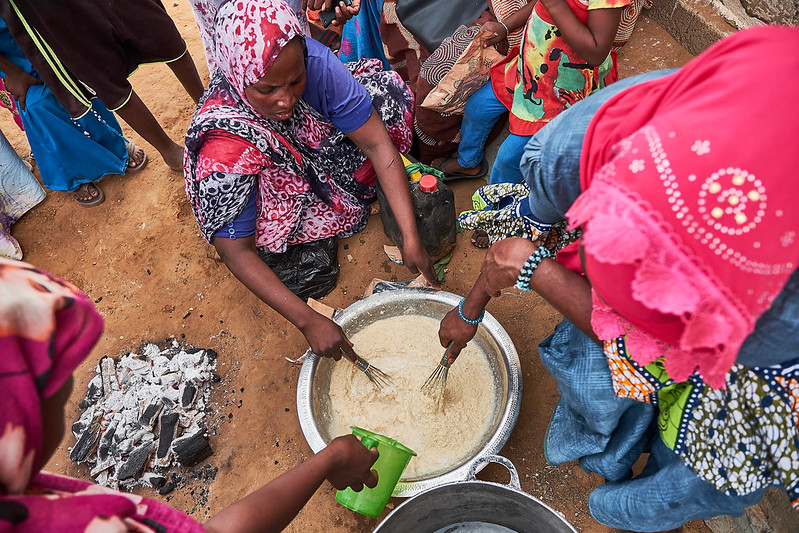Development agencies are pouring in billions of dollars to address the global food crisis exacerbated by Russia’s war on Ukraine. The World Bank, the G7, the European Union’s Team Europe, and the United States have collectively pledged more than $40 billion to avert food and humanitarian crises. Yet this much-needed assistance carries its own risks. Without a gender lens, the proposed measures will fail to meet the specific needs of women and girls and might worsen existing gender inequalities. The current crisis presents an opportunity to design gender-responsive programs that buffer women and girls against hardships in the short term and tackle entrenched gender inequalities while building resilience to future shocks over the long term.
It is a perilous moment for women and girls around the world. The COVID-19 pandemic already pushed an estimated additional 47 million girls and women into extreme poverty, reversing decades of progress. And in 2021, at least 150 million more women than men were experiencing food insecurity—with the gender gap continuing to grow. Crises pose particular risks to girls, leading to them to drop out of school at higher rates, and increasing the incidence of gender-based violence including early or forced marriage, and economic or sexual exploitation.
The war in Ukraine has led to price spikes of key staple foods, fuel, and agricultural inputs around the world, posing special risks for low-income countries with dependence on food and fertilizer imports. Rising food insecurity and malnutrition pose the greatest risks for children and pregnant and lactating women, who may suffer repercussions to health and productivity that can affect future generations. The rising cost of fuel and farm inputs threatens to widen the gender gap in agricultural productivity and other economic opportunities, leading to further reductions in women’s income and household food security.
The strain on government budgets will likely shift spending away from social programs, limiting the provision and expansion of social protection measures needed to reach women and children. Other responses to the crisis, such as the provision of fertilizer subsidies or vouchers, are more likely to reach male heads of household as gender disparities in access to resources or services like financial accounts and mobile internet are ignored. Moreover, many of the practices proposed to address the crisis, such as the use of agro-ecological practices, may add to the already high labor burdens of women and girls.
Alarmed that the crisis response would ignore gendered impacts, IFPRI’s Gender, Climate Change, and Nutrition Integration Initiative (GCAN), with support from USAID, convened a roundtable of concerned donors, academics, and practitioners. The group identified eight actions, now published in a Nature Comment, that chart a course for concrete, gender-responsive actions to support the needs of women and girls:
- Gather evidence. Gender-responsive approaches require data on food crises broken down by sex that are timely, accessible, and localized. Monitoring longer-term effects on women’s empowerment and well-being is also essential. Without such data, gender-blind investments are difficult to avoid.
- Extend anti-violence programs. Crises raise the risk of gender-based violence both inside and outside the home, including early and forced marriage as a coping mechanism. More services for those who experience violence are needed, as are prevention measures. These include cash transfer programs, measures designed to keep girls in school, and programs that address harmful attitudes and norms by working with men and boys.
- Expand social protection. Evidence abounds that social protection programs can protect women and children during food crises. It should be a priority to expand these programs to women who are not formally in the labor force and those whose businesses were forced to close or are struggling.
- Increase opportunities for decent work. Women need support to run businesses, including farming. Such support includes childcare, business development centers, and access to finance, as well as targeted procurement of goods and services from women farmers and entrepreneurs.
- Support women’s groups and networks. Existing social networks and women’s groups are essential to direct resources to women and girls. They can also boost resilience by providing a platform for collective action, sharing labor and childcare responsibilities, organizing transport, accessing credit and savings, and disseminating information.
- Tailor financial services to women. Waiving women’s access barriers, such as registration fees or collateral requirements, while simultaneously increasing financial literacy, should be part of any program fighting food insecurity.
- Broaden access to information. To counteract current agriculture and food insecurity challenges, women need information on less labor- and input-intensive farming practices and how to safely store food to prevent contamination and minimize food waste. Increasing their ownership of mobile phones and training on how to use them is essential to access extension messages and market information increasingly delivered through digital platforms.
- Promote women’s leadership. Women leaders and women’s organizations need equal and meaningful participation in decision-making spaces at multiple scales to develop more inclusive processes, design gender-responsive interventions, coordinate implementation across sectors, and monitor and evaluate the gendered impacts of the crisis response. Only if women’s voices are formally represented in crisis planning and response will programs be more equitable and effective.
The current global food crisis is not the last crisis the world will face, but it should be the last one in which women and girls carry this grossly unequal burden. Now is the time to build more resilient and equitable food systems that create more opportunities for women and girls, leading to greater gender equality and greater prosperity for all.
Elizabeth Bryan is a Senior Scientist with IFPRI’s Environment and Production Technology Division (EPTD); Claudia Ringler is EPTD Deputy Division Director. Opinions are those of the authors.







